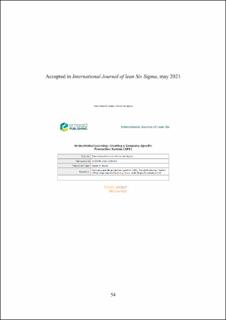| dc.contributor.author | Hekneby, Torbjørn | |
| dc.contributor.author | Ingvaldsen, Jonas A | |
| dc.contributor.author | Benders, Jos | |
| dc.date.accessioned | 2021-08-25T11:20:24Z | |
| dc.date.available | 2021-08-25T11:20:24Z | |
| dc.date.created | 2021-08-23T15:55:07Z | |
| dc.date.issued | 2021 | |
| dc.identifier.citation | Hekneby, T., Ingvaldsen, J. A. & Benders, J. (2021). Orchestrated learning : creating a company-specific production system (XPS). International Journal of Lean Six Sigma. | en_US |
| dc.identifier.issn | 2040-4166 | |
| dc.identifier.uri | https://hdl.handle.net/11250/2771159 | |
| dc.description | Author's accepted manuscript. | en_US |
| dc.description | This author accepted manuscript is deposited under a Creative Commons Attribution Non-commercial 4.0 International (CC BY-NC) licence. This means that anyone may distribute, adapt, and build upon the work for non-commercial purposes, subject to full attribution. If you wish to use this manuscript for commercial purposes, please contact permissions@emerald.com. | |
| dc.description.abstract | Purpose: Companies create company-specific production systems (XPS) by tailoring generic concepts to fit their unique situation. However, little is known about how an XPS is created. This paper aims to provide insights into the creation of an XPS.
Design/methodology/approach: A retrospective case study was conducted in a Norwegian multinational company over the period 1991–2006, using archival data and interviews.
Findings: The development of the XPS did not start with a master plan. Instead, dispersed existing initiatives were built upon, along with an external search for novel ideas. Widespread experimentation took place, only later to be combined into a coherent approach. Once established, the XPS was disseminated internally and further refined. The CEO orchestrated the experimentation by facilitating the adaptation and combination of different concepts and by allocating resources to institutionalize the XPS in the global network.
Originality/value: This paper is the first to study how an XPS is created. This study contributes with novel empirical insights, and it highlights the role of top management in facilitating experimentation and step-by-step organizational learning. | en_US |
| dc.language.iso | eng | en_US |
| dc.publisher | Emerald | en_US |
| dc.rights | Navngivelse-Ikkekommersiell 4.0 Internasjonal | * |
| dc.rights.uri | http://creativecommons.org/licenses/by-nc/4.0/deed.no | * |
| dc.title | Orchestrated learning : creating a company-specific production system (XPS) | en_US |
| dc.type | Journal article | en_US |
| dc.type | Peer reviewed | en_US |
| dc.description.version | acceptedVersion | en_US |
| dc.subject.nsi | VDP::Samfunnsvitenskap: 200::Økonomi: 210::Bedriftsøkonomi: 213 | en_US |
| dc.source.journal | International Journal of Lean Six Sigma | en_US |
| dc.identifier.doi | https://doi.org/10.1108/IJLSS-09-2020-0139 | |
| dc.identifier.cristin | 1928127 | |
| cristin.qualitycode | 1 | |

